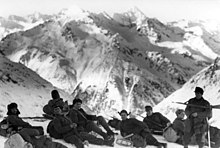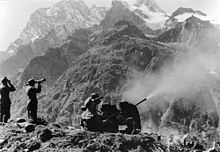Edelweiss company
1941: Białystok-Minsk - Dubno-Lutsk-Rivne - Smolensk - Uman - Kiev - Odessa - Leningrad blockade - Vyazma-Bryansk - Kharkov - Rostov - Moscow - Tula
1942: Rzhev - Kharkiv - Company Blue - companies Braunschweig - company Edelweiss - Stalingrad - Operation Mars
1943: Voronezh-Kharkov - Operation Iskra - North Caucasus - Kharkov - Citadel Company - Oryol - Donets-Mius - Donbass - Belgorod-Kharkov - Smolensk - Dnepr
1944: Dnepr-Carpathians - Leningrad-Novgorod - Crimea - Vyborg-Petrozavodsk - Operation Bagration - Lviv-Sandomierz - Jassy-Kishinew - Belgrade - Petsamo-Kirkenes - Baltic States - Carpathians - Hungary
1945: Courland - Vistula-Oder - East Prussia - West Carpathians - Lower Silesia - East Pomerania - Lake Balaton - Upper Silesia - Vienna - Oder - Berlin - Prague
Edelweiss was the code name for the second part of the German summer offensive in the Soviet Union that began on July 23, 1942, following the Fall Blau company . The aim of the operation was to secure the oil reserves in and around Baku .
Planning and preparation
In directive No. 45 of July 23, 1942, Adolf Hitler redefined the objectives of the Braunschweig company . The aim was the simultaneous advance of German troops both in the direction of the Caucasus (company Edelweiss) and in the direction of Stalingrad ( company heron ). Hitler intervened in the planning of the operation several times and made certain decisions, in particular the division of Army Group South against the council of the OKH . Army Group A under the command of General Field Marshal Wilhelm List , intended for Edelweiss , comprised the German 1st Panzer Army ( von Kleist ) and 17th Army ( Ruoff ) including a Romanian cavalry corps and stood at the start of the operation on the lower reaches of the Don near Rostow . She received air support from Luftflotte 4 ( Richthofen ).
Various companies were founded in Germany in preparation for the development of the oil wells. Personnel have been trained and materials have been made available to repair any damage to the oil production systems.
The defense began by the Shamil company to secure the regions of Grozny , Malgobek and Maikop .
Course of operation
On July 20, 1942, the 17th Army began to attack Rostov from the Taganrog area . The "Gateway to the Caucasus" was created in cooperation with XXXXIX. Mountain Corps with the III. and LVII. Panzer Corps captured and a southern Don bridgehead built at Bataisk . Overall, the following operations in terms of gaining space in the Caucasus took place within a few weeks, then a tough trench war began.
The advance from July 25th
On July 25, Army Group A's general advance into the Caucasus was initiated:
On the right wing: 17th Army ( Ruoff )
- 5th Army Corps ( Wetzel ) with 9th , 73rd , 125th and 198th Infantry Divisions
- XXXXIV. Army Corps ( Angelis ) with 97th and 101st Jäger Divisions
- LVII. Panzer Corps ( Kirchner ) with SS Division Wiking , Division Greater Germany and Slovak rapid division
- XXXXIX. Mountain Corps ( Konrad ) with 1st and 4th Mountain Divisions , as well as Romanian 2nd Mountain Division
In the middle: 1st Panzer Army ( von Kleist )
- III. Panzer Corps ( Mackensen ) with 13th Panzer Division and 370th Infantry Division
- XXXX. Panzer Corps ( Geyr von Schweppenburg ) with 3rd and 23rd Panzer Divisions
Left wing 4th Panzer Army ( Hoth )
- XXXXVIII. Panzer Corps ( Kempf ) with 14th and 16th Panzer Divisions and 29th Motorized Division
- IV Army Corps ( Schwedler ) with 94th and 371st Infantry Divisions
- Romanian VI. Army Corps ( Dragalina ) with Romanian 10th, 19th and 20th divisions
- LII. Army Corps ( Ott ) with the 98th and 111th Infantry Divisions
The attack of the Don bridgeheads took place on July 25 between Bataysk and Zymljanskaja , the 3rd Armored Division reached the breakthrough, they crossed the Sal at Orlowsk and reached on July 29, the Manych . On August 4, Stavropol (then Voroshilovsk) was captured by the 3rd Panzer Division and the Kuban sector crossed to the south. Maikop fell into the hands of the 13th Panzer Division on August 9, and the entrances to the Ossetian and Georgian Army Roads were taken into possession on the left. On August 9th the attack on Krasnodar began , which was taken by the 9th, 73rd and 198th Infantry Divisions by August 11th, and on August 14th the German 5th Army Corps crossed the Kuban on a broad front.

Novorossiysk , at that time the largest remaining base of the Soviet Black Sea Fleet , was reached on August 28th by the 73rd and 125th Infantry Divisions . The V Army Corps opened the attack on the port, which fell into German hands on September 6th after fighting with the Soviet 47th Army .
In the high mountains the XXXXIX. Mountain Corps captured the most important pass crossings. The 1st Mountain Division captured the Gluchor Pass on August 17th and crossed the passes on a broad front to the south - they still reached the Abkhazian mountain village Pßchu , 20 kilometers off the coast of the Black Sea near Gudauta . The Elbrus massif was taken, and on August 21, the German war flag waved on the summit . Romanian units managed to roll up the Soviet defense on the east coast of the Sea of Azov from the north. Temryuk fell on August 24, and the Taman Peninsula was opened from "backwards". A first attack by the XXXXIV, begun on August 26th. Army corps on the port of Tuapse was stopped after two days, but on August 31, the port city of Anapa was taken by Romanian troops after heavy fighting.
At the beginning of September the company started Blücher , parts of the XXXXII. Army Corps of 11th Army landed on the Strait of Kerch on the peninsula Taman . The 46th Infantry Division , which landed next to the Romanian 3rd Mountain Division, occupied Taman on September 4th .
East of the Elbrus stood the German XXXX. Armored corps and Romanian troops in the Baksan and Terek rivers to Naurskaya . On August 25, the 3rd Panzer Division succeeded in capturing Mozdok and by August 30, a southern bridgehead over the Terek was built near Cherskaya. To the north of it the front advanced to the Kuma , where the LII. Army corps was used for cover to the east. Between the Nogaj steppe and the Kalmyk steppe as far as Elista , only the 16th motorized division secured .
Change of leadership
On September 9, Hitler relieved Field Marshal List, whom he accused of not adhering to his operational guidelines, of his command as Commander in Chief of Army Group A. The severe leadership crisis in Army Group A also led to the replacement of Chief of Staff Franz Halder at the end of September . By November 22, 1942, Hitler took over the leadership of Army Group A personally and then commissioned von Kleist with the supreme command.
Final offensive movements and initiation of retreat
Further attacks by the 17th Army in the direction of the port of Tuapse , carried out until mid-December, failed due to stubborn resistance from the Soviet 18th and 56th Armies . The 1st Panzer Army tried in vain to break through an enclosure from the east to the oil areas near Grozny , the resistance of the Soviet 58th and 44th Armies visibly hardened. In the battle of Nalchik (October 25 - November 12) an attack on Grozny from the west via Alagir was intercepted by the Soviet 9th Army . At the beginning of November the III. Panzer Corps give up last attempts to break through in the direction of Ordzhonikidze .
The offensive movements of the Army Group came to a complete standstill when, at the end of November, the encirclement of the 6th Army ( Operation Uranus ) near Stalingrad posed a serious threat to the troops south of the Don. First, the 23rd Panzer Division was detached and transported to Kotelnikowo , and on November 25th, strong Soviet counter-attacks began in the area south of Mozdok. When the Soviet troops fended off the German relief attack Operation Wintergewitter for the trapped 6th Army at the end of December and started the counter-offensive in the south with the North Caucasian operation , Army Group A had to surrender the occupied areas in the Caucasus. A new Soviet 28th Army was activated from the Astrakhan area and attacked through the Kalmyk steppe against the open flank of Army Group A to the west. The goal of the German southern offensive, the conquest and exploitation of the oil wells in the Grozny area, was not achieved.
The withdrawal movement, initiated on December 31, took place in three stages, with the Kuban bridgehead being maintained until October 9, 1943 despite constant narrowing.
consequences
This fragmentation of forces, against which Hitler had been warned several times by his generals, is today generally regarded as the main cause of the sinking of the 6th Army in the Battle of Stalingrad . For his insistence on the company, Hitler had put forward economic reasons (conquest and utilization of the Caucasian oil wells, cutting off Soviet goods transports on the Persian corridor via the Stalingrad traffic junction ).
literature
- Walter Hubatsch: Hitler's instructions for warfare 1939–1945. Documents of the High Command of the Wehrmacht . Edition Dörfler in Nebel-Verlag, Utting 2000, ISBN 3-895-55173-2 .
- Carl Wagener : Army Group South , Podzun Verlag, Bad Nauheim 1972, p. 154 f.
- Rudolf Konrad : Battle for the Caucasus , Copress-Verlag Hoffmann & Hess, Munich, no year.
Web links
- Алексей Валерьевич Исаев (AW Isaew): НА КАВКАЗ ЗА НЕФТЬЮ ("For the oil in the Caucasus", in Russian).

